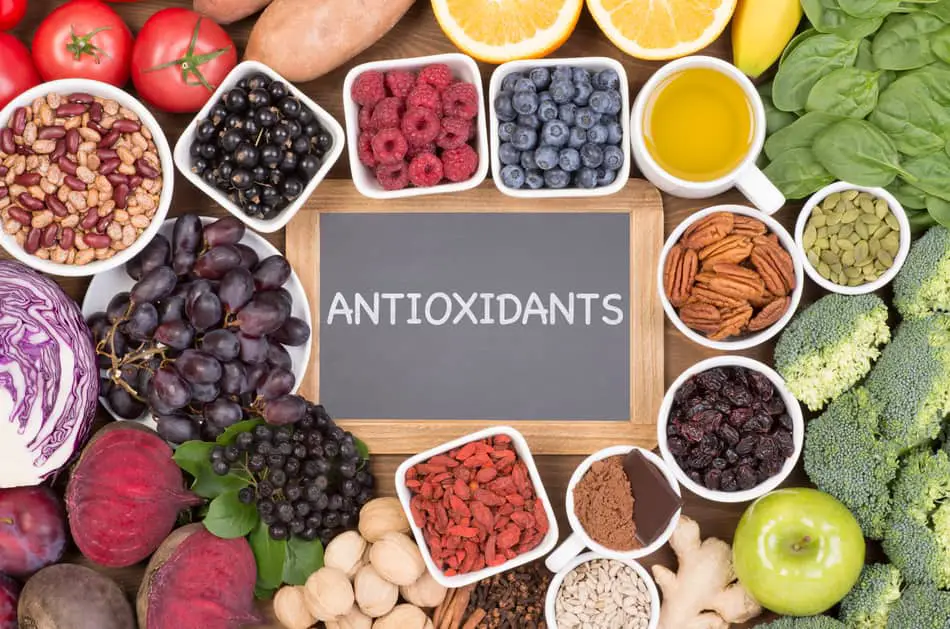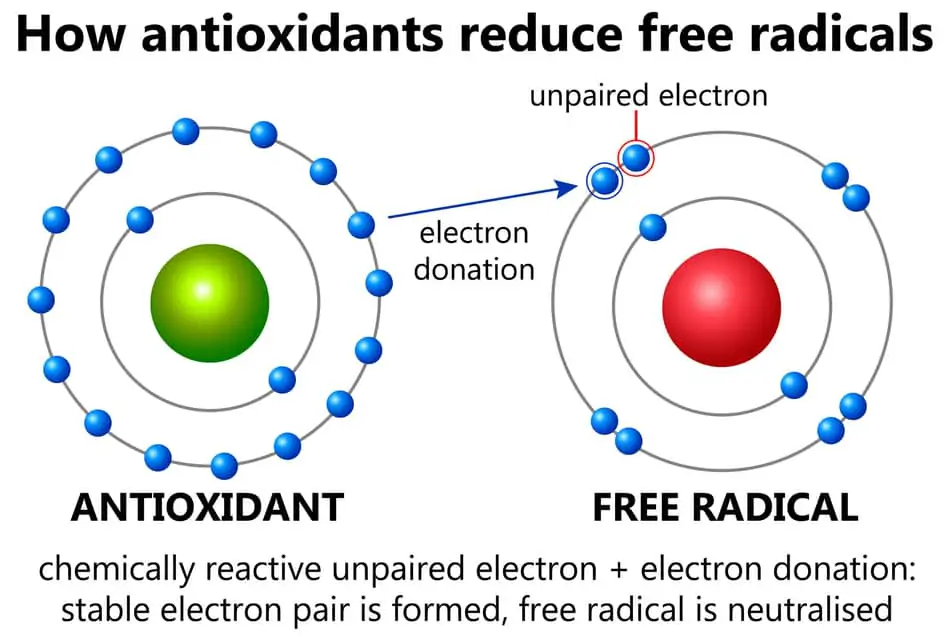
Experts often advise us to eat foods high in antioxidants. And you can find a lot of information on good food sources of antioxidants, like deeply colored fruits and vegetables. But what are the names of these antioxidants, exactly? There are hundreds, likely even thousands of antioxidants—some of which haven’t been discovered yet. So there may never be a complete list, but this is a good start.
Names of Antioxidants—The List
Antioxidants can be divided into vitamins, carotenoids, minerals, phenolic compounds, and other compounds. Vitamins C and E, and beta-carotene, are among the most powerful antioxidants. These and others that we know the most about, with the most robust antioxidant action on our bodies, are on this list:
- Vitamins
- Vitamin C
- Vitamin E
- Carotenoids
- Carotenes
- Alpha-carotene is similar chemically to beta-carotene
- Beta-carotene is responsible for the orange pigmentation in carrots and other plant foods
- Lycopene is responsible for the red pigmentation in tomatoes and other plant foods
- Xanthophylls
- Lutein is thought to work best in combination of its isomer, zeaxanthin
- Zeaxanthin is thought to work best in combination of its isomer, lutein
- Beta-cryptoxanthin is a precursor to vitamin A
- Carotenes
- Minerals
- Selenium
- Manganese
- Zinc
- Phenolic Compounds
- Quercetin is a part of the flavonoid group of polyphenols and is found in a wide range of different colored plants
- Catechins are part of the flavonoids group of polyphenols and are are found in a wide range of different colored plants
- Resveratrol is part of the stilbenes group of polyphenols and is responsible for the blue and purple colors of some plants
- Coumaric acid is part of the hydroxycinnamic group of polyphenols and is found in a wide range of different colored plants
- Anthocyanins are part of the flavonoid group of polyphenols, and are responsible for the purple/blue pigmentation of some plants
- Proanthocyanins are flavanols, part of the flavonoid group of polyphenols, and are responsible for the purple/blue pigmentation of some plants
- Ellagic Acid is part of the hydroxybenzoic acid group of phenolic acids and is responsible for the red pigment in some plants
- There are many more less well-understood and/or less abundant phenolic compounds
- Other
- Glutathione is produced in cells and is a combination of three amino acids: glutamine, glycine, and cysteine. Levels decrease with age and poor sleep
- Coenzyme Q10 (CoQ10) is a vitamin-like substance made by the body but levels decline with age and use of certain drugs like certain statins, beta blockers and antidepressants
- Alpha Lipoic acid neutralizes free radicals in both the fatty and watery regions of cells, in contrast to vitamin C (which is water soluble) and vitamin E (which is fat soluble)
If you’d like to learn which foods antioxidants show up in, you may be interested in my articles on these antioxidants by color:
What are the red phytonutrients?
What are the purple/blue phytonutrients?
What are the red/orange phytonutrients?
What exactly are antioxidants, anyway?
What Are Antioxidants?
As a normal by-product of burning energy, our bodies turn some atoms or molecules into free radicals. Free radicals can also be generated by external sources such as pollution, pesticides, heavy metals, alcohol, tobacco, certain drugs and radiation.1
Free radicals are unstable because they have one or more unpaired electrons. This causes the atom or molecule to try to “steal” electrons from other compounds to gain stability. In so doing, they damage the other compound1.
How Are Free Radicals Harmful?
Free radical damage is associated with aging and many diseases including2:
- Diabetes
- Neurological disorders including Parkinson’s, Alzheimer’s, MS ( multiple sclerosis)
- Cardiovascular diseases including atherosclerosis and high blood pressure (hypertension)
- Asthma
- Cataracts
- Rheumatoid arthritis
- Cancers including of the colon, prostate, breast, lung, and bladder
How Do Antioxidants Benefit Us?
Antioxidants combat the damage of free radicals by generously giving away electrons without becoming free radicals themselves.

“Antioxidant” isn’t really a substance, it’s an action—it’s anything that inhibits oxygen. Many compounds have antioxidant properties, which means they neutralize oxidation, but they may perform other functions as well.
Studies show that antioxidants are the most help to us when they are in the form of food rather than supplements3.
Science does not yet understand if the protective effects of high antioxidant foods are due to the antioxidants by themselves, other compounds in the foods, or the ways they all interact together.
Are Antioxidants Interchangeable?
Antioxidants are not a single class of substance. Some compounds are not on the list but have antioxidant properties, meaning they are capable of donating an electron. For example, there is some debate about whether vitamin A is an antioxidant or a pro-oxidant. Vitamin A is essential to life (in the right quantities), but we are still learning about what it does and how it works10.
Antioxidants do not all work the same way, so they are not interchangeable. In fact, in some circumstances antioxidant substances, which are electron donors, can become electron stealers1. Each antioxidant has unique chemical properties that behave in different ways in the body. Aiming to take in as many different types of antioxidants, by eating a wide variety of plant foods in your diet, is the best way to benefit from antioxidants.
Should You Supplement With Antioxidants?
In general, you should get your nutrients from whole food. We benefit most from antioxidants and other nutrients when they are injested together, along with the fiber and other compounds (some of which science may not be aware of yet) that work together to your benefit3.
There are some studies that showed that taking antioxidants not only didn’t help people, but harmed them4,5,6,7,8,9.
Why don’t supplements benefit us as much as food? It may be that differences in the type of antioxidants in foods versus those in supplements cause different effects. For an example mentioned by the Harvard T. H. Chan School of Public Health1, there are eight chemical forms of vitamin E in foods. However, vitamin E supplements typically only include one form, alpha-tocopherol. Supplementing with only the one form may cause an imbalance that does more harm than good. Although more research is needed.
The exception is of course if you have a diagnosed deficiency in any essential nutrients. In that case, supplement under your physician’s supervision.
What about the well-publicized AREDS formulas of antioxidants for macular degeneration? Read this article by ophthalmologist Cynthia J. MacKay identifying important concerns about the study designs and objectivity of its authors.
Hope this list of antioxidants was handy! You might also be interested in:
Do vegans live longer? Here is what the science says.
What is the healthiest nut variety? The complete guide is here
Can you bake with almond milk? Answers and tips here.
Resources
1. Phaniendra A, Jestadi DB, Periyasamy L. Free radicals: properties, sources, targets, and their implication in various diseases. Indian J Clin Biochem. 2015;30(1):11-26. doi:10.1007/s12291-014-0446-0.
2. https://www.hsph.harvard.edu/nutritionsource/antioxidants/
3. Chen, F., Du, M., Blumberg, J. B., Ho Chui, K. K., Ruan, M., Rogers, G., Shan, Z., Zeng, L., & Zhang, F. F. (2019). Association Among Dietary Supplement Use, Nutrient Intake, and Mortality Among U.S. Adults: A Cohort Study. Annals of internal medicine, 170(9), 604–613. https://doi.org/10.7326/M18-2478.
4. Semba RD, Ferrucci L, Bartali B, Urpí-Sarda M, Zamora-Ros R, Sun K, Cherubini A, Bandinelli S, Andres-Lacueva C. Resveratrol levels and all-cause mortality in older community-dwelling adults. JAMA internal medicine. 2014 Jul 1;174(7):1077-84.
5. Lee IM, Cook NR, Gaziano JM, Gordon D, Ridker PM, Manson JE, Hennekens CH, Buring JE. Vitamin E in the primary prevention of cardiovascular disease and cancer: the Women’s Health Study: a randomized controlled trial. JAMA. 2005 Jul 6;294(1):56-65.
6. Milman U, Blum S, Shapira C, Aronson D, Miller-Lotan R, Anbinder Y, Alshiek J, Bennett L, Kostenko M, Landau M, Keidar S. Vitamin E supplementation reduces cardiovascular events in a subgroup of middle-aged individuals with both type 2 diabetes mellitus and the haptoglobin 2-2 genotype: a prospective double-blinded clinical trial. Arteriosclerosis, thrombosis, and vascular biology. 2008 Feb 1;28(2):341-7.
7. Hennekens CH, Buring JE, Manson JE, Stampfer M, Rosner B, Cook NR, Belanger C, LaMotte F, Gaziano JM, Ridker PM, Willett W. Lack of effect of long-term supplementation with beta carotene on the incidence of malignant neoplasms and cardiovascular disease. New England Journal of Medicine. 1996 May 2;334(18):1145-9.
8. Hercberg S, Galan P, Preziosi P, Bertrais S, Mennen L, Malvy D, Roussel AM, Favier A, Briançon S. The SU. VI. MAX Study: a randomized, placebo-controlled trial of the health effects of antioxidant vitamins and minerals. Archives of internal medicine. 2004 Nov 22;164(21):2335-42.
9. Cook NR, Albert CM, Gaziano JM, Zaharris E, MacFadyen J, Danielson E, Buring JE, Manson JE. A randomized factorial trial of vitamins C and E and beta carotene in the secondary prevention of cardiovascular events in women: results from the Women’s Antioxidant Cardiovascular Study. Archives of internal medicine. 2007 Aug 13;167(15):1610-8.
10. William S. Blaner, Igor O. Shmarakov, Maret G. TraberAnnual Review of Nutrition 2021 41:1, 105-131. Vitamin A and Vitamin E: Will the Real Antioxidant Please Stand Up?
